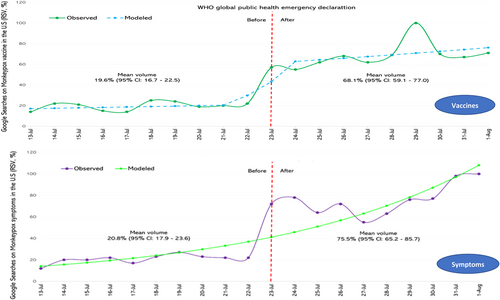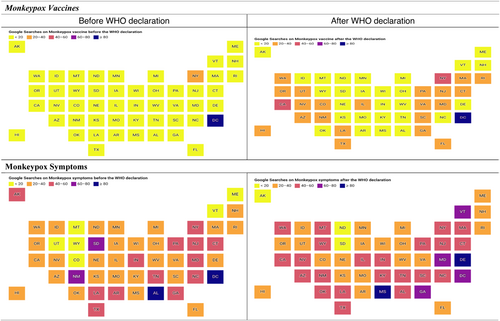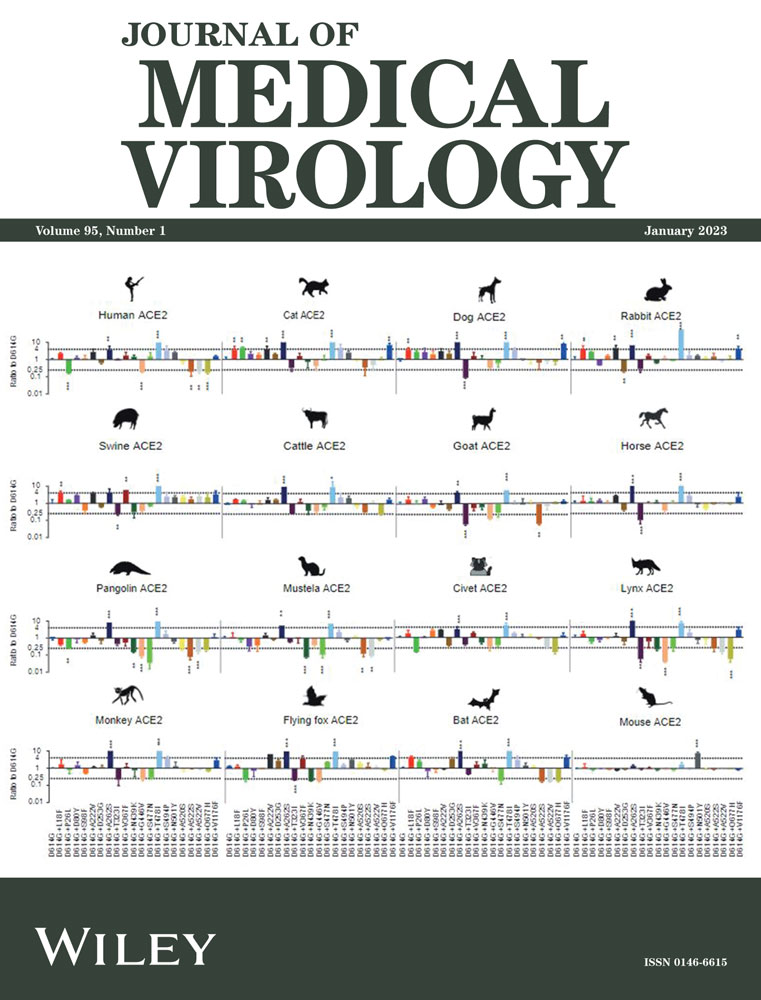Monkeypox outbreaks, international health emergency declaration, and Americans' interest in preventing the disease
To the Editor,
With the first few cases being reported in non-endemic countries by May 2022, soon, the Monkeypox disease (MPXD) outbreaks received widespread global scientific and popular media attention. Within 3 months, by early November 2022, the global MPXD burden rose to more than 75,000 cases with the majority of the countries reporting cases.1 Amidst the rising number of MPXD cases worldwide, scholars and experts vehemently called for coordinated regional and global action plans, deployment of vaccines, greater surveillance and protection of vulnerable communities, and dissemination of evidence-based health information on MPXD prevention, signs, and symptoms. To initiate concrete global actions, many experts also discussed the declaration of MPXD a global public health emergency and some scholars from heavily affected countries also called for national public health emergencies.2-5
After some criticism and calls for action, the WHO finally declared MPXD as a Public Health Emergency of International Concern (PHEIC) on July 23rd, 2022.2-6 Such declarations (e.g., PHEIC from the WHO) have been discussed and questioned for their potential value and the decision-making processes involved. For MPXD too, experts questioned whether or not the MPXD-related PHEIC would spur action or help initiate regional and global plans and actions to reduce morbidity and prevent the rampant transmission of the disease.2, 6, 7 Others questioned the timing and content of the MPXD PHEIC declaration statement, called for publishing a detailed global plan of action with the declaration, asked about the role of individual countries, and also, acknowledged the profound challenges (e.g., political) that this declaration would face.6-8 Four major recommendations were listed in the WHO MPX-related PHEIC declaration statement. Considering the broad nature of these recommendations, the aforementioned concerns about the potential impact of this MPXD-related PHEIC declarations seem appropriate.7-10 One of the most critical questions that remains unanswered about such PHEIC declarations is how these declarations affect public awareness and population health information-seeking behaviors.
Given the lack of empirical evidence on the impact of a WHO PHEIC on public awareness about a disease, the aforementioned concerns related to MPX PHEIC declaration, and the fact that the United States had the highest number of MPXD cases worldwide, we explored answers to two major questions as it relates to MPX disease in the United States. First, we wanted to assess the level of Americans' interest in preventing MPX disease (measured by exploring public online searches for MPXD vaccines and symptoms). Second, we wanted to explore whether the WHO MPXD-related PHEIC declaration made a difference in the American people's information-seeking for MPXD prevention.
A brief Infodemiology analysis was conducted using Google Trends (GTs) to assess the extent of internet searches for Monkeypox Symptoms and Monkeypox Vaccine before and after the WHO MPXD-related PHEIC declaration. GT is a publicly available data source of public Google search data that provides data in the form of relative search volumes (RSVs) on a selected topic at a specific time and normalizes the data to allow for appropriate comparisons. The RSV data is presented in a normalized range of 0 (low) to 100 (highly popular searches) for a topic, specific time, and location selected.3, 11 We collected public Google search data via GT from July 13 to August 1, 2022. The study period was subsequently divided into two groups of 10 days before (July 13–22, 2022) and 10 days after (July 23 to August 1, 2022) the WHO MPXD-related PHEIC announcement. We used Joinpoint regression analysis which involves fitting a series of joined straight lines on a log scale to assess the trends over time. In our analysis, Joinpoint regression results indicate the trends in time-specific estimates from aggregated data to depict modeled versus observed RSVs by time. We also retrieved US state-level RSV on the search terms Monkeypox Symptoms and Monkeypox Vaccine.
Figure 1 indicates trends in internet searches for MPXD vaccines and symptoms among the general public in the United States with a dramatic increase in searches for these terms after the WHO MPXD PHEIC declaration. While Figure 1 illustrates both observed and modeled searches, observed searches were used to compute the relative increase in RSV for MPXD vaccines and symptoms before and after the PHEIC declaration (RSV T2-RSV T1/RSV T1 × 100%; where T1 and T2 indicate the times before and after the declaration). The relative increase in searches after the PHEIC declaration for MPXD vaccines and symptoms was 248% and 263%, respectively (compared to before the declaration). Interestingly, there was a dramatic peak on July 29th, 2022 for “vaccine” search but not “symptoms”; this needs further exploration regarding what spiked public interest on MPXD and related terms (e.g., it could have been due to approvals of additional vaccines for MPXD in the United States on July 27th).12 Also, it should be noted that PHEIC declaration announcement was made on a Saturday in July—the impact of the day/time of such announcements should be explored as it relates to public interest in disease outbreaks and searches conducted by the general public regarding these disease outbreaks.

In our US state-level analysis for RSV changes (Figure 2), except for one state (New York), Monkeypox Vaccine RSVs were <20% across all the states before the WHO PHEIC declaration. After the PHEIC declaration, 21 states had RSVs of 20%–40% and 2 states had RSVs of >40%. Similarly, before the PHEIC declaration Monkeypox Symptoms RSVs were <20% for 6 states, 20%–40% for 28 states, and >40% for 16 states. After the PHEIC declaration, the RSV for Monkeypox Symptoms was <20% for 3 states, 20%–40% for 20 states, and >40% for 27 states. This increase in searches across most states for MPXD symptoms and vaccines does not correspond with a proportionate increase in MPXD cases across individual states providing further evidence of the potential impact of the MPXD PHEIC declaration.1, 10 There were certain surprising and exceptional trends as well. For instance, Alabama was >80 and dropped to 40–60, New Mexico was in the range of 60–80 and dropped to 40–60, and South Dakota was in the range of 60–80 and dropped to <20 (in before and after declaration comparisons). The dropping of RSVs after PHEIC declaration in some states needs further exploration.

Infodemiology studies have been conducted extensively during the COVID-19 pandemic to understand population health needs.3, 11 Our brief Infodemiology analysis on MPXD suggests that the WHO PHEIC declaration increased the general American public's interest in preventing this disease (with online searchers for MPXD vaccines and symptoms used as indicators of interest). While providing empirical evidence on the potential impact of a PHEIC, our analysis raises several questions. First, despite the MPXD cases rising exponentially worldwide and low public awareness,1, 3, 6, 7 did the WHO unnecessarily delay the declaration of a PHEIC? Also, the WHO PHEIC declaration statement should have been accompanied by a concrete global action plan (including strategies for increasing public awareness and stigma reduction on MPXD).4, 9, 10 Second, despite the United States having rampant MPXD transmission, individual states declaring emergencies, and the highest number of MPXD cases, the US government did not declare a national public health emergency until August 4th, 2022.1, 4, 10 Did the US government miss an opportunity to by not declaring a national public health emergency immediately after or with the WHO PHEIC declaration? In the United States, a public health emergency declaration helps bolster resources and responses to a serious disease outbreak. Our analysis suggests that an emergency declaration may have at least increased public interest in MPXD prevention. Third, if the American public or people from other countries are now more likely to be interested in MPXD prevention after the PHEIC declaration, can they get reliable and accurate information online?3-5 Do we have the same problem of medical misinformation with MPXD that we had during the COVID-19 pandemic? Finally, if the American public or people elsewhere are more interested in MPXD prevention, do we have the resources for prevention (e.g., vaccines) and treatment (e.g., medication) to meet the public demand? We strongly encourage the policymakers to be as transparent as possible which will help mobilize and energize the public as we prepare for what may lie ahead.
CONFLICT OF INTEREST
The authors declare no conflict of interest.
Open Research
DATA AVAILABILITY STATEMENT
All study data are freely available to interested individuals at: https://trends.google.com/trends/?geo=US




